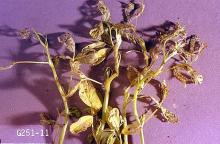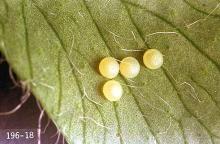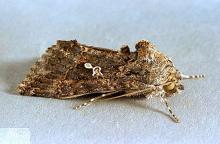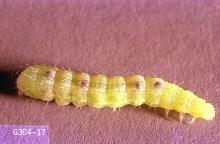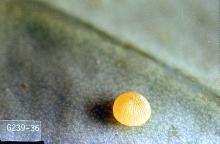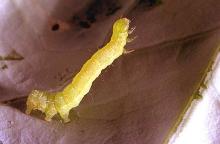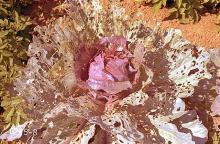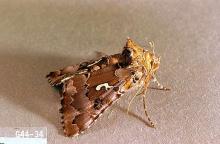Includes
Alfalfa looper (Autographa californica)
Cabbage looper (Trichoplusia ni)
Pest description and crop damage Larvae of both species are pale green with white lines on backs and sides. Larvae have three pairs of abdominal prolegs, whereas cutworms and armyworms have five pair. Larvae of loopers move in a "looping" manner similar to inchworms and range in size from 1 to 1.5 inches long. Moths are gray-brown with a silvery oval and a U-shaped white or cream-colored spot in the shape of a dog leg on forewings.
In the Willamette Valley, damage during the early season (May and early June) may appear serious. However, the plant almost always repairs the damage by harvest. This generation is usually heavily parasitized, greatly reducing potential for late-season damage from this pest.
Scouting and thresholds Inspect fields in June and early July when scouting for the more serious pests such as mint root borer, variegated cutworm, and Bertha armyworm. Count loopers the same as these pests when doing ground searches for larvae and tallying numbers for each sq ft sample. Treatment levels, which vary with vigor and age of field and the price of mint oil, usually are from one to four larvae (total of all worm species per sq ft).
Management-biological control
Naturally occurring insect viruses are often very effective at keeping looper levels below the economic threshold. Off-color, flaccid and slow-moving larvae are indicative of viral infection. Parasitic wasps and flies usually minimize summer generation damage by killing larvae in May and June. Look for small black blotches on otherwise pale green and white larvae of loopers, as these usually indicate parasitization. This insect can be controlled with Bacillus thuringiensis formulations when larvae are small and leaf coverage is complete.
Management-cultural control
Larval feeding damage in May and June, particularly in western Oregon, is usually confined to those leaves that appear in the spring on the first regrowth nodes. The great majority of these leaves will become shaded out, senesce, and fall well before harvest. Thus, treating fields with an insecticide specifically for loopers at this stage is generally uneconomical and may reduce potential for biological control by killing beneficial insects.
Management-chemical control
- acephate (Acephate 90 WDG) at 1 lb ai/A. PHI 14 days. REI 24 hr. Retreatment interval 7 days. Do not exceed 2 lb ai/A per season, nor make more than two applications per crop season. The grazing of animals on treated areas, and the feeding of spent mint hay to animals are prohibited. Apply when eggs or insects first appear.
- azadirachtin (AzaMax) at 0.012 to 0.044 lb ai/A. PHI 0 days. REI 4 hr. Some formulations are OMRI-listed for organic use.
- Bacillus thuringiensis (there are several products containing various amounts of Bacillus thuringiensis)-Check each label for application rate. PHI 0 days. REI 4 hr. Treat mint when larvae are small. Some formulations are OMRI-listed for organic use.
- Burkholderia spp. (Venerate XC) at 1 to 4 quarts/A. PHI 0 days. REI 4 hr. OMRI-listed for organic use.
- chlorantraniliprole (Coragen) at 0.045 to 0.098 lb ai/A. PHI 3 days. REI 4 hr. Retreatment interval 14 days. Do not exceed 0.2 lb ai/A or 4 applications per calendar year. May be applied by chemigation.
- chlorantraniliprole/thiamethoxam (Voliam Flexi) at 0.1 to 0.125 lb ai/A. PHI 7 days. REI 12 hr. Retreatment interval 14 days. Do not exceed 15 oz/A Voliam Flexi or 0.188 lb ai/A of thiamethoxam or 0.2 lb ai/A of chlorantraniliprole per season. Apply in at least 10 gal water/A (ground) or 5 gal water/A (aerial). Do not use an adjuvant.
- Chromobacterium subtsugae (Grandevo) at 0.3 to 0.9 lb ai/A. PHI 0 days. REI 4 hr. May be applied by chemigation. Apply in at least 10 gal water/A. OMRI-listed for organic use.
- indoxacarb (Avaunt) at 0.065 lb ai/A. PHI 7 days. REI 12 hr. Retreatment interval 3 days. Do not exceed 0.26 lb ai/A per season or make more than 4 applications per year. May be applied by chemigation. Apply in at least 20 gal water/A.
- methomyl (Lannate SP) at 0.9 lb ai/A. PHI 14 days. REI 48 hr. Do not apply more than 1.8 lb ai/A per growing season or 4 applications. Restricted use.
- methoxyfenozide (Intrepid 2F) at 0.16 to 0.25 lb ai/A. PHI 14 days. REI 4 hr. Do not apply more than 1.0 lb ai/A per year. Time applications to small larvae and egg masses.
- spinetoram (Radiant SC) at 0.031 to 0.094 lb ai/A. PHI 7 days. REI 4 hr. Retreatment interval 4 days. Do not apply more than 0.305 lb ai/A per crop or make more than 4 applications per year. Do not make more than 2 successive applications of this or other group 5 insecticides (spinetoram and spinosad). Target eggs and small larvae.
- spinosad (Success, Entrust SC) at 0.062 to 0.156 lb ai/A. PHI 7 days. REI 4 hr. Retreatment interval 4 days. Do not exceed 0.45 lb ai/A per crop year, make more than four applications per calendar year or more than three applications per crop. Do not make more than 2 successive applications of this or other group 5 insecticides (spinetoram and spinosad). Target eggs and small larvae. Entrust SC is OMRI-listed for organic use.
- tebufenozide (Confirm 2F) at 0.09 to 0.12 lb ai/A early season and 0.12 to 0.25 lb ai/A mid to late season. PHI 14 days. REI 4 hr. Retreatment interval 10 days. Do not exceed 1 lb ai/A per season. Apply in at least 8 gal water/A to small plants and 10 gal water/A to dense stands. Addition of a spreader-binder is recommended.

